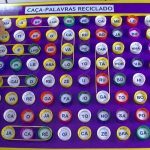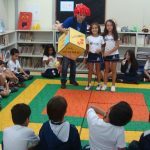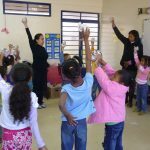Congratulations! the classes are very creative and interesting so that students can develop their playful learning.
Playful games with proper names in Kindergarten need to be diversified and offer new challenges to children, enhancing their learning. This is essential for both the figural and the conceptual aspects to be developed.

objective: Know the origin of your name.
Material: Sheets of legal paper.
Procedure: Propose children to make an interview with their parents, looking for the origin of their names. Assemble a form with the students to assist them in the interview, including questions such as:
– Who chose my name?
– Why am I called…? What does it mean… ?Agree with the class the day of the report and how it will be. (Teacher's choice)
Activity Suggestion: Tell the story of your name learned from the interview and illustrate it.
Interesting: On brown paper, the teacher will be able to record everyone's name and a summary of its origin and post it on the wall
Comments: Everyone must bring the interview on the appointed day, providing opportunities for the development of responsibility since small, and, if this does not happen, the teacher must be prepared and know what attitude to take towards this problem.
Objective: Know the spelling of your name with different graphic forms.
Required Material: Chips of the same size and shape and a shoe box.- Procedures: Set up a binder in the classroom with cards that show different ways of writing the name:
With capital block letter, small block letter, cursive letter. Making it clear to the child that there are different ways to write their name, but they all mean the same thing. Arrange with the class when and how they should use the cards. (According to the teacher)
You can have a 3×4 photo of the child on each card.
Suggested Activities: Identify the name; Write the name.
Objective: Identify the initial letter of your name in different words.
Materials: Scissors, Magazines, Newspapers, Leaflets, Glue, Craft sheets.
Procedures: Explore the initial letter of the name with the class. List other words that also start with that letter. Propose that they search newspapers, magazines and brochures for other words that also start with the letter of their name. Cut and paste the words onto craft sheets. Read the words found with the class and together look for the meaning.
Evaluation Suggestion: Recognize, in a list of words, those with the letter that starts your name.
Comments: The teacher can propose to the class that each day one brings a word from home that starts with the letter of their name and in class they find the meaning. This type of activity awakens in the student a greater interest in research and increasing vocabulary.
Objective: Know the letters and write your name through play.
Material: Moving letters that can be made of wood, EVA, cardboard, etc...
Procedures: Leave the letters exposed in the room so that the children have greater contact with the material. Propose that, at different times in class, children use the letters to try to write their names.
Evaluation Suggestion: Write your name in a joke.
Comments: This material allows the child to match letters, position and order them. If the letters are made of paper or cardboard, it would be interesting for the children to help in making their own material, guided by the teacher.
Objective: Know the letters that make up the writing of your name through the game.
Materials: cards of cardboard or cardboard; bottle caps or pebbles to mark the letters; drawing sheets; cards with the letters of the names; Glue; colored paper (to make paper balls) or used matchsticks.
Procedure: Each child will receive a card with their name written on it. The teacher will draw the letters, saying the name of each one so that the children can identify them. Each drawn letter must be marked on the card if it is in your name. Once the card is filled, the student must shout: BINGO! As soon as they finish the game, an individual report will be proposed, with the distribution of cards with the letters of the name (One card for each letter) delivered out of order. The children should sort the cards, composing their name, and place them on a work sheet. The teacher asks you to count how many letters there are in the writing of your name and proposes that you stick the representative amount on matchsticks or paper balls on the sheet.
Assessment Suggestion: Recognize the letters that are part of the writing of your name on cards.
Observation: It is interesting to repeat the game several times during the activities before proposing the report.
Objective: Recognize the writing of your name from the writing of the names of all colleagues.
Materials: Cards with the writing of all names (one for each name) and chairs.
Procedures: The teacher asks the children to make a circle with the chairs. Then distribute the cards with the names for the children to pin them on the chairs. The chairs dance begins, where at the end of the song each person must sit on the chair where the card with their name appears.
Evaluation Suggestion: Perform the game several times, always changing the chairs.
Objective: Write your name.
Materials: Numbered balloons, tokens numbered according to the balloons and with names and chalk.
Procedures: Form the children into two rows. Distribute a card with a number to each child. Given the signal, one at a time runs to the balloons and pops the one with your number. Inside will be a card written your name. The child should read the name aloud and reproduce it on the floor using chalk.
Goals: Be part of the group, knowing how to wait for your turn to play. Recognize the letters in your name. Sort the letters that make up your name.
Materials: Boards with comics needed for writing the name in white. Data with the letters of the names of the members of the group. Cards with the letters.
Procedures: Distribute students into small groups. Match the groups that only one child at a time will throw a dice, identifying which letter was drawn. If this is part of your name, you must take the corresponding token and place it on the board.
Evaluation Suggestions: Carefully participate in the game and identify the letters of your name.
Also check out our post from –> ACTIVITIES WITH THE NAME
Did you like it? Share this post on your social network
 TONGUE LOCKER ACTIVITY IDEAS
TONGUE LOCKER ACTIVITY IDEAS
 LITERACY GAMES TO MAKE
LITERACY GAMES TO MAKE
 RECREATIONAL ACTIVITIES FOR EARLY CHILDHOOD EDUCATION
RECREATIONAL ACTIVITIES FOR EARLY CHILDHOOD EDUCATION
 PLAY TO CALM THE CHILDREN
PLAY TO CALM THE CHILDREN
 ACTIVITIES ON UPPER AND SMALL LETTERS
ACTIVITIES ON UPPER AND SMALL LETTERS
 Games and Pranks about Body Expression
Games and Pranks about Body Expression
Congratulations! the classes are very creative and interesting so that students can develop their playful learning.
This site uses Akismet to reduce spam. Learn how your comment data is processed.